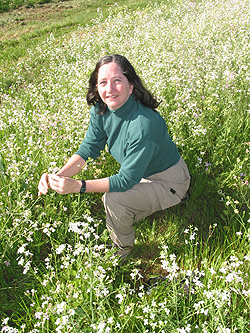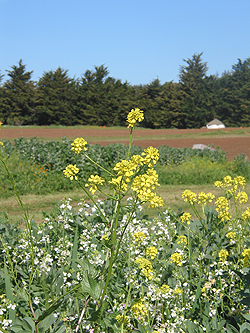|
March 29, 2004
UCSC scientists investigate impact of genetically
modified plants on wild relatives of major California crop
By Jennifer McNulty
As an environmental scientist, Deborah Letourneau believes policy decisions
should be based on the best information available at the time.
|

Deborah Letourneau is surrounded by wild radish, above. Letourneau
is looking at the impact of genetically modified crops on their
wild relatives, such as wild radish and wild mustard, below.
Photo: Jennifer McNulty

|
That’s why she’s trying to fill an information gap with
her latest research on genetically modified plants.
As insect-resistance is bred into major crops, Letourneau wonders how
those crops’ wild relatives might be affected if they pick up the
new traits.
“There’s been a lot of research on crop-to-crop movement,”
said Letourneau, referring to the contamination of organic corn grown
adjacent to genetically modified (GM) corn. “But we don’t
know that much about the biology of wild crop relatives. If genes transferred,
would it make them more weedy, more hardy, more invasive?”
To address these questions, Letourneau, a professor of environmental
studies at UCSC, along with doctoral candidate Joy Hagen and Ingrid
Parker, an associate professor of biology, have begun a three-year study
to see what the consequences would be if GM genes transferred from Brassica
plants through cross-pollination to their wild relatives.
Plants in the Brassica, or cole, family include many vegetable
crops, such as broccoli, Brussels sprouts, cabbage, cauliflower, and
kohlrabi, as well as common weeds like wild radish and wild mustard.
“Weed problems translate into economic problems for farmers,”
said Letourneau, noting that 75 percent of cole crop production in the
United States is concentrated on the Central Coast of California. Stubborn
weeds require more herbicide applications, with accompanying higher
labor costs and environmental impacts, she said, adding that highly
invasive weeds can threaten native species on nonagricultural lands,
too.
Letourneau is a leading authority on the genetic modification of plants.
A member of the National Academy of Sciences’ 12-member panel investigating
the environmental consequences of GM plants, she also coedited the 2002
book, Genetically Engineered Organisms: Assessing Environmental and
Human Health Effects. Parker’s background is in applying mathematical
models to ecological risk assessment for GM crops.
A growing number of crops are being genetically modified to increase
insect resistance. More than 25 percent of corn grown in the United
States has been genetically engineered to contain the toxin of the Bacillus
thuringiensis (Bt) soil bacterium, which disrupts the digestive
system of a caterpillar. Transgenic cotton and potatoes also produce
Bt toxin.
Little is known about the role Bt-susceptible herbivores, including
caterpillars, play in regulating the health and spread of wild crop
relatives. In their research project, Letourneau and Hagen are protecting
wild relatives from caterpillar damage to see what could happen if modified
genes moved from Brassica crops to their wild relatives.
The simulation is necessary because the research is being conducted
in open fields--not inside greenhouses--where risks of contamination
by GM plants would be high, said Letourneau. To mimic an effect of gene
transfer, the UCSC researchers are spraying Bt on wild radish and wild
mustard growing adjacent to commercial cole crops, and they will use
models to evaluate the subsequent fitness, weediness, and invasiveness
of the weedy relatives, said Letourneau.
“We can’t use real transgenic crops, but we wanted to conduct
this work where wild relatives live side-by-side with commercial crops,”
said Letourneau. Research sites include the UCSC Farm and agricultural
parcels adjacent to natural ecosystems from Wilder State Park to Elkhorn
Slough Reserve.
Genetic links between crops and weeds are remarkably common, and cole
crops are no exception, noted Parker. “In the past, the evolution
of many weeds has been driven by genes coming from crops,” she
said. “Now those genes will be specially engineered by humans.”
Research on consequences for wild relatives is overdue, said Letourneau,
noting that field-testing of GM cole crops for California has been under
way since 1999.
“This kind of research is important now, during the process of
risk assessment, to know whether new modified crops should be deregulated
or not,” she said. “There are a lot of Bt crops in the pipeline.
Anything we can find out now can be used by regulators to make more
informed decisions.”
Letourneau takes nothing for granted as the research gets under way.
The project will use a large number of sample plants on varied research
sites, and the experiments will be replicated over three years.
Hazards of GM corn, including allergenicity and contamination of adjacent
fields, were identified during extensive testing that was required because
it is a food.
Because similar tests are not required on nonfood plants, it’s
harder to know what the hazards might be, and what the probability is
that they’ll occur, said Letourneau. “It might be that transgene
movement to wild relatives would be no problem at all,” she said.
“If we don’t detect any problems or hazards, we’ll feel
we’ve tried to provide the data needed for risk assessment.”
The three-year project, funded by a $335,000 grant from the U.S. Department
of Agriculture, is something of a conquest for Letourneau.
“I’ve been trying since 1995 to get this research funded,”
she said, referring to early studies of gene transfer that showed the
likely crossing of traits from GM crops to wild relatives.
Return to Front Page
|